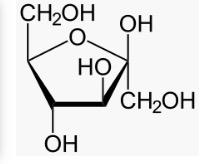It was once just innocent fruit sugar, but fructose now vies for the number one slot as the world’s biggest, baddest nutrient, making us fat and sick. Which is all nonsense of course…
No need to fear fructose!
Sugar may be the latest bête noire in nutrition, but for the shun-everything-sweet brigade there seems to be a special place in hell reserved for poor old fructose.
Given fructose is found naturally in fruit, along with fiber and vitamins, you’d think the sugar might be given a break, But, when partnered with the words “high, corn and syrup” it seems fair game to give this particular sugar a big bashing – indeed to pronounce it “toxic”, or even “deadly”.
According to the USDA Economic Research Service, per capita high fructose corn syrup (HFCS) consumption started ramping up from a base of virtually nothing in the 1970s, taking off in the mid 1980s and peaking in 1999 at 11.1 teaspoons. Consumption has declined slowly and steadily since 2002, to an intake of 6.5 teaspoons per person in 2018.
Meanwhile, per capita, beet and cane sugar (sucrose) consumption has hovered between 10.4 and 12.2 teaspoons per day since 1983, after steadily decreasing from a peak of 17.8 teaspoons per day in 1972.
Because the increased use of HFCS more or less mirrors the rapid increase in obesity in America, fructose has been scape-goated as a major suspect in the fattening and sickening of our society. But it’s a cheap shot that makes no scientific sense.
For one, some countries with a similar rise in obesity have never embraced HFCS at all – in Britain for example, body fatness and type 2 diabetes has also increased over a broadly comparable time frame, but HFCS has never taken off as a sweetener there at all. Instead sucrose from cane and beet sugar are the preferred forms of sugar being used by the UK food industry.
Second, “high fructose” is a complete misnomer as the most common forms of HFCS contain either 42% or 55% fructose, referred to in the food industry as HFCS 42 and HFCS 55.
Just like “high fructose” corn syrup, sucrose (table sugar), is also made up of glucose and fructose, in a one-to-one ratio. The only difference is that in sucrose, the glucose and fructose are joined; once stomach acid and gut enzymes have broken down the chemical bond between them (which occurs rapidly), equal amounts of sugar and HFCS yield very similar amounts of fructose. And of course it makes not a jot of difference to the body where the fructose comes from.
Unlike glucose, fructose does not stimulate insulin release or need insulin for transport into cells. Also unlike glucose, which can be metabolized in many different cells, fructose is largely metabolized by the liver, which is where some of the misrepresentations about “fructose equals fat” begin.
According to the fructose-is-evil theory, the sugar is a terrible thing to eat as it gets turned into fat in the liver, creating a fatty liver, which in turn directly creates insulin resistance.
While some studies do show that large doses of fructose will increase fat deposition in the liver, the amounts used are generally far more than is normally consumed in the diet.
The truth is that glucose and fructose both raise levels of liver fat about equally when given to overweight subjects, but only when calories are in excess overall. Neither fructose or glucose raise levels of liver fat when subjects are in energy balance.
In normal healthy subjects not mainlining calories or sugars, isotope tracer studies tell us that around 41% of fructose is converted to glucose within 3-6 hours of ingestion. Most of the fructose (or the glucose formed from it) is either burned for energy or stored as glycogen. Only around 1% of ingested fructose gets directly converted to fat.
Fructose is also blamed for overriding appetite regulation and making people hungrier, but again the evidence doesn’t stack up in the real world.
The most widely cited study along these lines gave subjects either 30% of calories as pure glucose or 30% as pure fructose for one day: it found those consuming pure fructose had lower circulating levels of leptin and less ghrelin suppression, which together might suggest a bad scenario for appetite control.
However, when similar experiments were done, but using closer to real world diets (30% of calories from high-fructose corn syrup or 30% of calories from sucrose), neither replicated these results and all of the differences in short-term energy regulating hormone levels disappeared.
And that’s the thing, we don't just eat large amounts of fructose on its own, we eat it in actual food, almost always in conjunction with glucose.
Though there’s no question that as a population we tend to overeat all sugars, it’s this overconsumption in general – or more specifically the excess calories that come with too many sugary foods and drinks – that is the issue for health and weight, not anything about fructose specifically.




